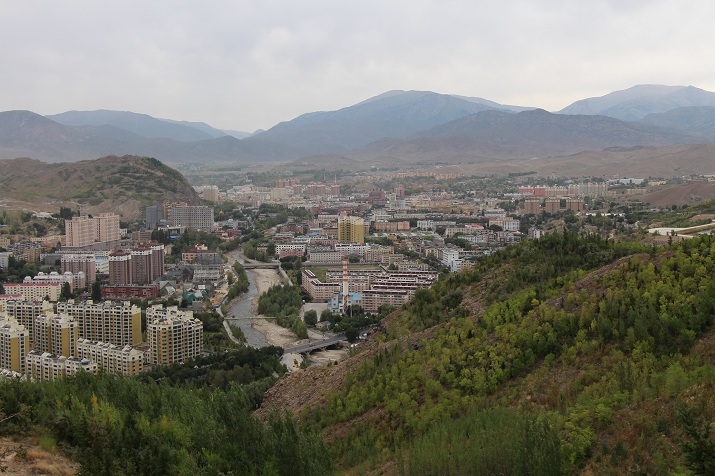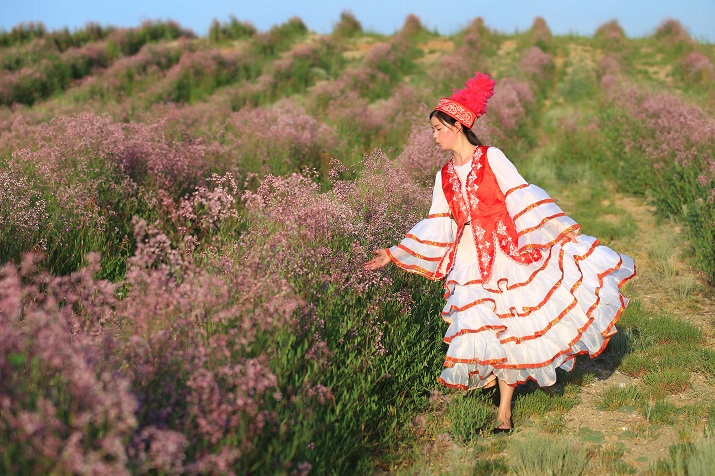|
||||||
|
||||||
| Home Nation World Business Opinion Lifestyle China Focus ChinAfrica Multimedia Columnists Documents Special Reports |
|
||||||
|
||||||
| Home Nation World Business Opinion Lifestyle China Focus ChinAfrica Multimedia Columnists Documents Special Reports |
| Nation |
| A Blooming Desert |
| One plant changes the destiny of a town in the Gobi Desert |
| By Liang Xiao | NO. 43 OCTOBER 25, 2018 |
 An aerial view of Altay in northwest China's Xinjiang Uygur Autonomous Region on August 27 (LIANG XIAO)
For 42-year-old Zeng Guo, sandstorms are a lasting horrible memory. He was born and raised in the Gobi Desert in Alahake, a town in Altay, northwest China's Xinjiang Uygur Autonomous Region. In the past, residents had no way to resist a sandstorm. As a result, when it came, they were forced to hide indoors. "The problem of sandstorms was severe in the Gobi Desert. Every three or five days, a wave of sandstorms would arrive, lasting five to seven days. Standing in my family's field, I could only see our patch of land; the rest of the world was full of yellow sand," Zeng told Beijing Review. But now, through planting gaubau kender, a special herb found only in the Gobi Desert in Altay, the once sandstorm-torn town has turned green, with its residents having increasing incomes. Zeng, now a manager of a plantation base of gaubau kender, is one of the beneficiaries from this change. In Alahake, over 85 percent of the 11,500 registered households are from the Kazakh ethnic group, whose main production model is animal husbandry. The town is famous for a salt lake which has been the source of salt for herders since ancient times. Located in the desert, without a water supply, the salt content of the lake water is relatively high, affected by a strong evaporation. In the mid-1960s, salt fields established here were able to produce 600-700 tons of salt for livestock per year. Because of the natural environment, vegetation to support livestock, like cattle and sheep, is insufficient. Thus, in order to eat, these animals often dig up plant roots. Consequently, the development of the ecological environment in the area is trapped in a vicious cycle and what the residents of Alahake were faced with was a huge survival crisis. Beneficial flowers Two years after Zeng was born, and owing to the implementation of the reform and opening-up policy, Zeng's family contracted for more than 2 mu (0.13 hectares) of farming land and later gradually rented some more land from herders. After getting married, Zeng took the load in the family from his father and continued to work hard on their land. He and his wife specialized in growing sunflowers that could be irrigated with light salt water. They earned about 30,000 yuan ($4,300) a year in around 2005. But this type of work meant a lot of uncertainty for the couple. Farmers do not have the ability to forecast fluctuating crop trends. Affected by various factors, the harvest for some years did not lead to profits, as the purchase price plummeted. Suffering from the risks of the traditional agriculture industry, Zeng once came up with the idea of giving up farming and finding a job in the town, which he failed to put into practice then because at the time, there were no enterprises in the town. Moreover, he did not have the heart to leave his aging parents whom he felt a duty to care for. Meanwhile, in Shenzhen, thousands of kilometers away from Altay, Liu Qizhen, a textile entrepreneur, was traveling in west China with experts, looking for a plant with high-quality fiber that was said to be extinct, bluish dogbane. The plant was first discovered in 1952 by Dong Zhengjun, a famous agricultural economist, on the Luobu Plain in Xinjiang, where they grew wild. Finally, in Alahake, Liu found 8.2 hectares of patches of a plant that was identified as different from previous bluish dogbane species recorded in the authoritative Flora of China. The new one was named Altay Gaubau Kender. Regarded as the gem of the Gobi Desert, gaubau kender is full of treasures. Its petals can be used as a raw material for cosmetics. The leaves, which grow for more than three years, can be fried and made into tea, with a price tag of up to 1,000 yuan ($144) per kg. After seven years, the stems can be made into fibers, and the clothes made of these fibers have good effects on health and also claim a high price. What is most remarkable about the herb is its role in combating sandstorms. Its roots are extremely developed, the perennial roots can survive for more than 30 years and new horizontal roots appear every year. Hence, gaubau kender has significant influence on the prevention of sandstorms and the reservation of water. In February 2006, Zeng became a member of the first batch of employees of Altay Gaubau Tea Co. Ltd. founded by Liu. In an experimental greenhouse in the Gobi Desert, Zeng and his colleagues planted the first artificially cultivated gaubau kender. Today, the area for standardized plantation in Alahake is 1,460 hectares, while the area for the recovery of wild gaubau kender is 4,020 hectares. Every year, from June to August, the Gobi Desert is now transformed into a boundless red ocean of gaubau kender blossoms, which lasts nearly 100 days.  A tourist in ethnic costume walks among gaubau kender flowers in Altay in northwest China's Xinjiang Uygur Autonomous Region on June 15, 2016 (XINHUA)
Common wealth "We do not rely solely on one company to protect the ecological environment. In the first half of this year alone, more than 20,000 trees were planted for afforestation, organized by the government of the town. In addition, we also put great effort into the promotion of forage cultivation. This attempt is strongly supported by local herders, because although the initial purpose is to optimize the use of land and protect the ecology, the cost of raising livestock is reduced at the same time," Liu Xingpu, an official from the local government, told Beijing Review. Under the joint efforts of the government, enterprises and residents, Alahake's environment has been improved to a large degree. Except for an occasional wind, large scale sandstorms have basically been eliminated. Since Zeng became a member of the company's management, his family's income has increased sevenfold, however they still farm the contracted land as well. It is no longer the major source of income for the family, but rather a pleasure and a joy. Because of the better environment, the output of the land has increased greatly. Other people have also benefited from the development of the gaubau kender industry in Alahake. Liu Xiaoyu, a member of the Board of Altay Gaubau Tea Co. Ltd., told Beijing Review that more than 5 million yuan ($720,970) is paid to farmers and herders for temporary work. Currently, Zeng's team consists of more than 50 regular employees, 70 percent of whom are local residents and more than 50 percent ethnic minorities. During the harvesting time, the plantation base also hires a large number of farmers and herders in surrounding areas as temporary workers, paying them 200-400 yuan ($29-58) per day. In addition to part-time jobs, local residents have more opportunities to increase their income. They used to spend money on cleaning up livestock feces; however, today the tea company needs manure in large quantities for the improvement of land fertility. Consequently, by selling the manure, herders' annual income increased by 1,000 yuan ($144). Along with the improvement of the ecology, the gaubau kender plantation base is now a famous national scenic spot. To serve the increasing number of tourists and lead the residents to common wealth, the town government has attached great importance to the flourishing development of the tourism industry. Relevant policies are being formulated to encourage farmers and herders to build restaurants and family inns with local features. On Zeng's social media account, he posts news related to gaubau kender and videos about the charm of Gobi Desert's four seasons, showing his love for the land he is bound to. Copyedited by Rebeca Toledo Comments to zanjifang@bjreview.com |
About Us | Contact Us | Advertise with Us | Subscribe
|
||
| Copyright Beijing Review All rights reserved 京ICP备08005356号 京公网安备110102005860号 |